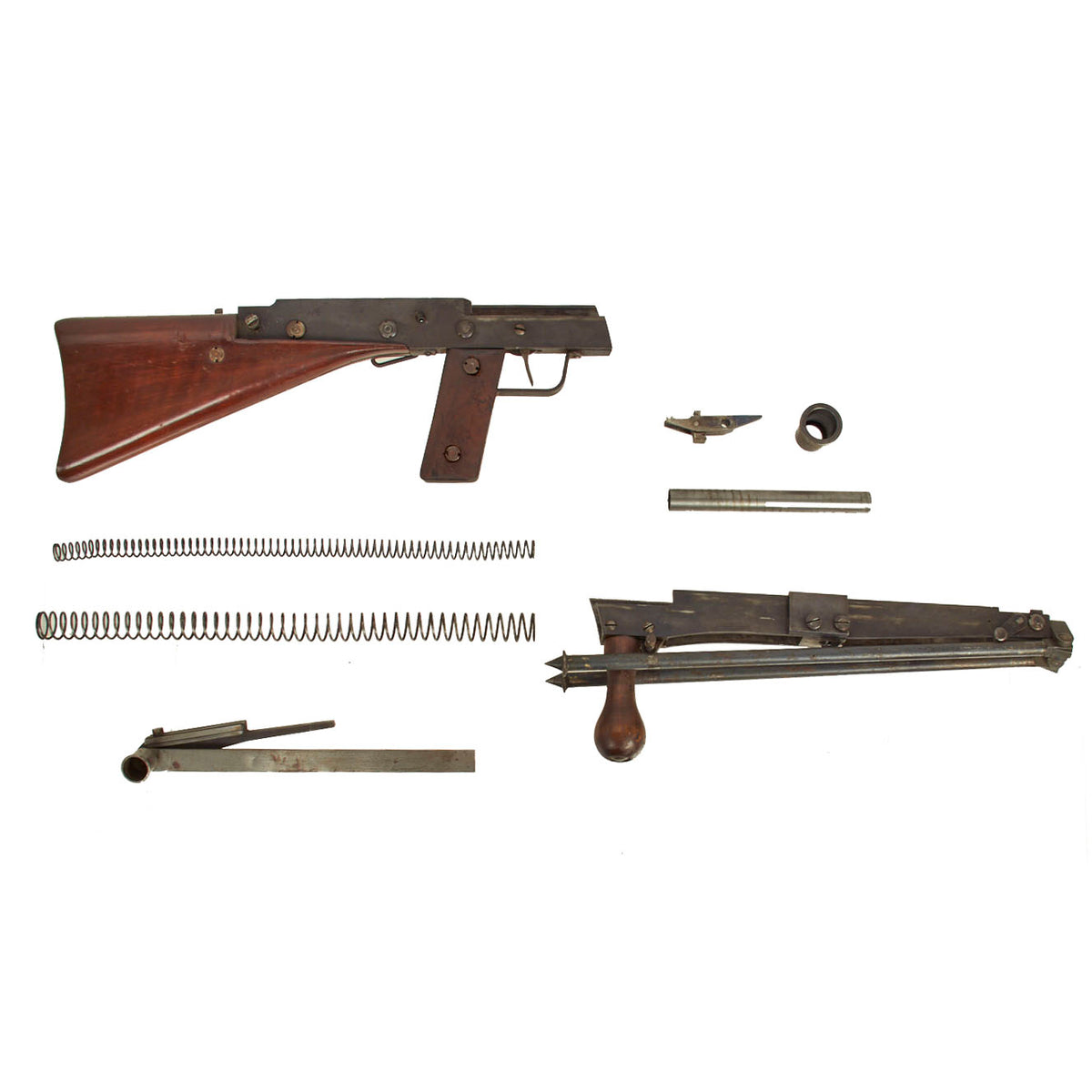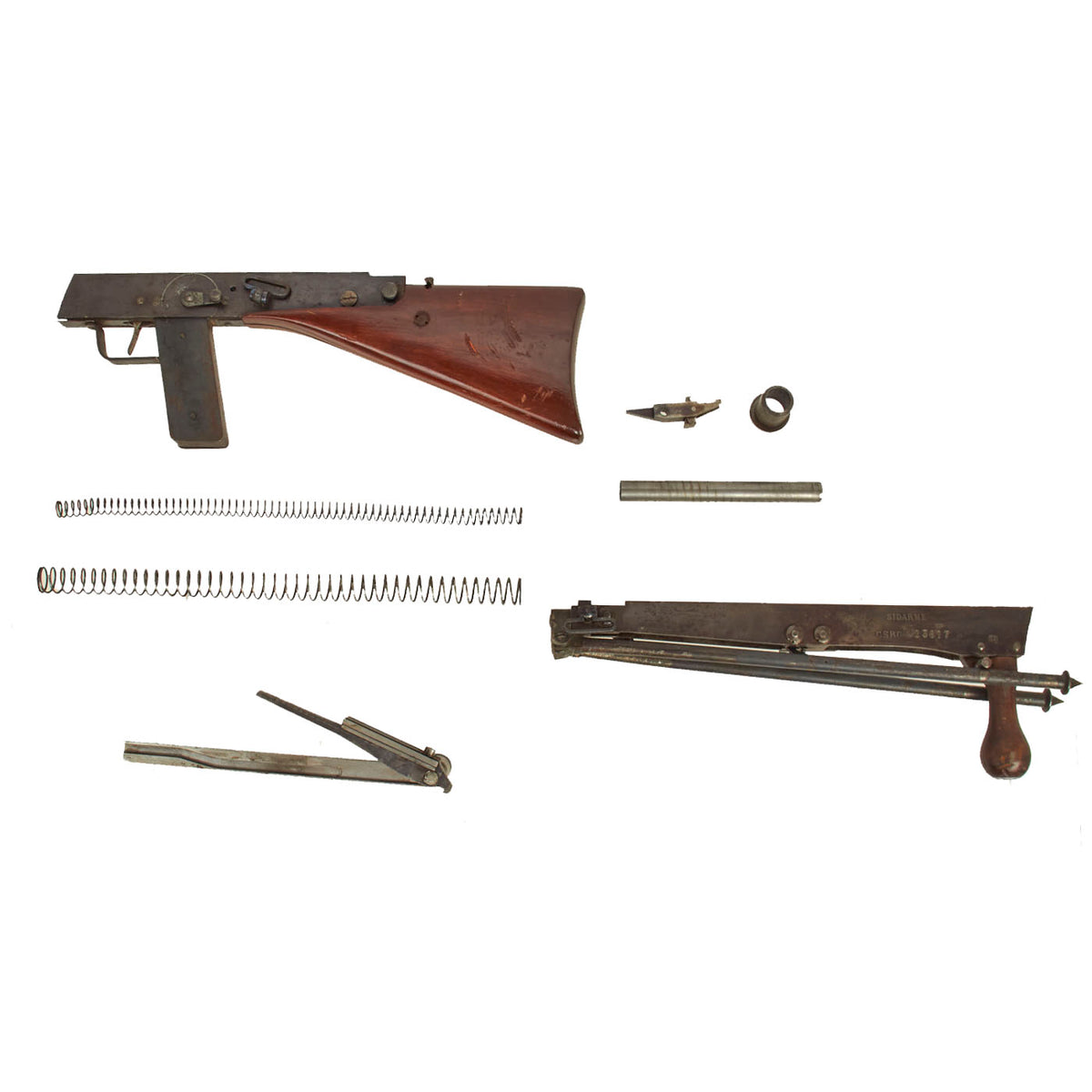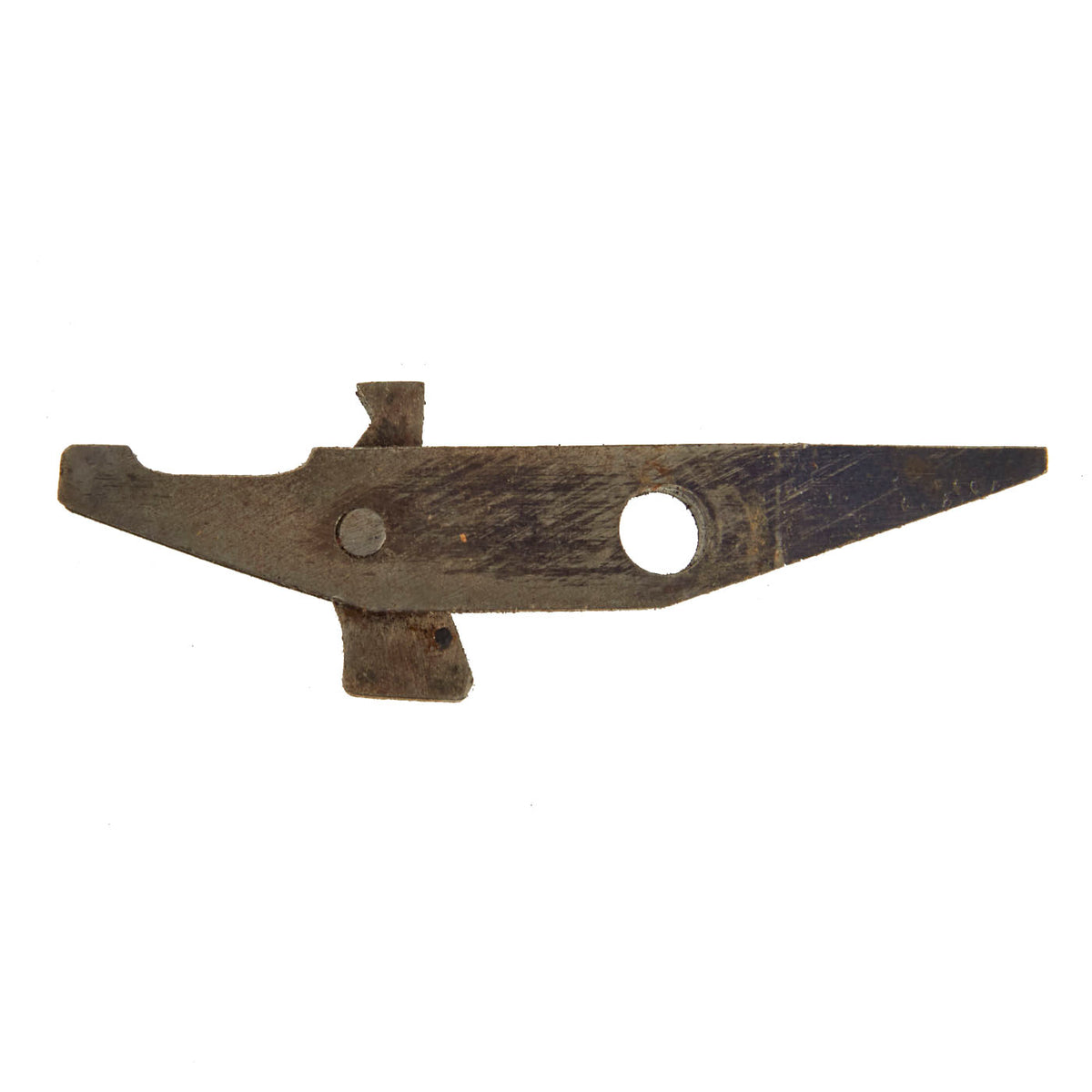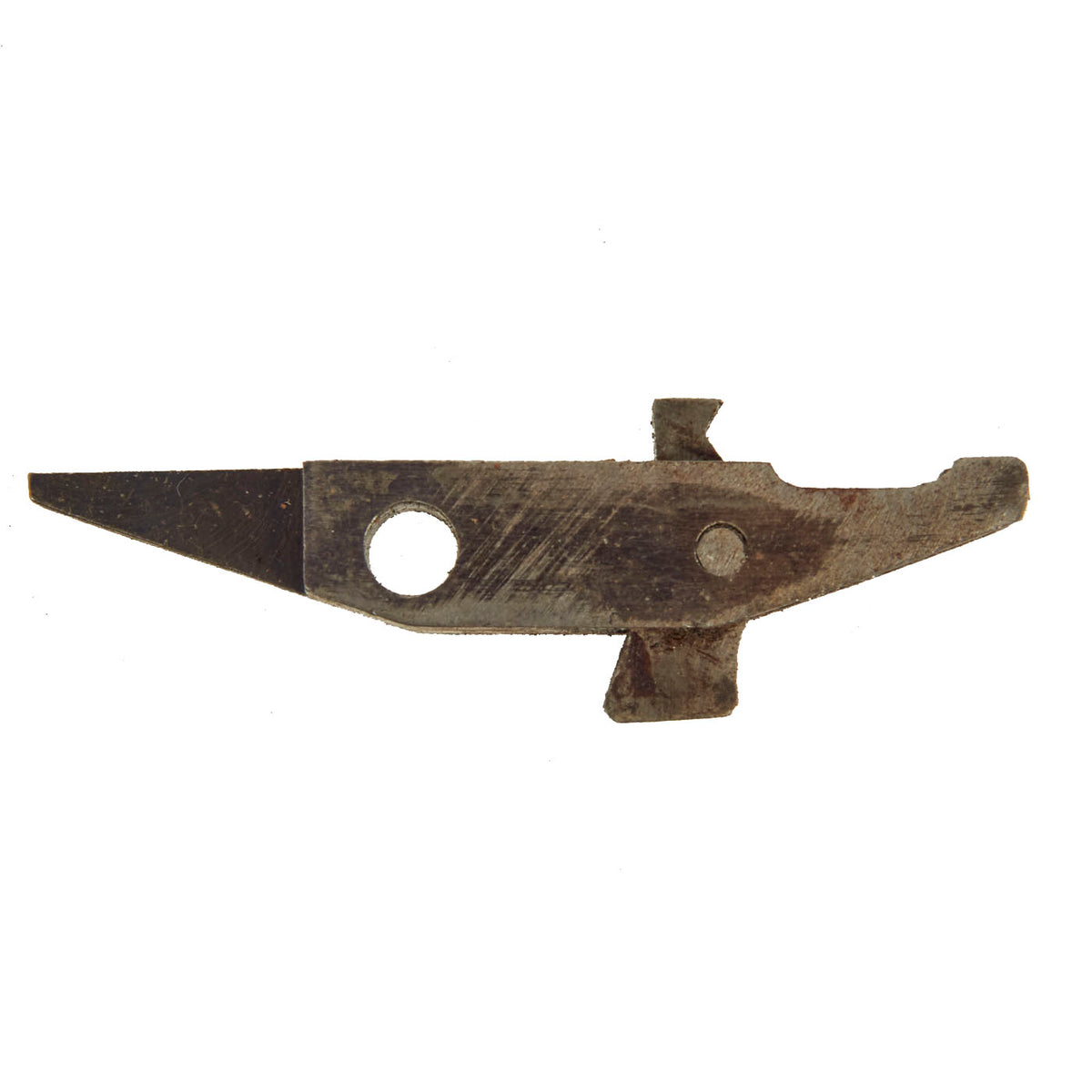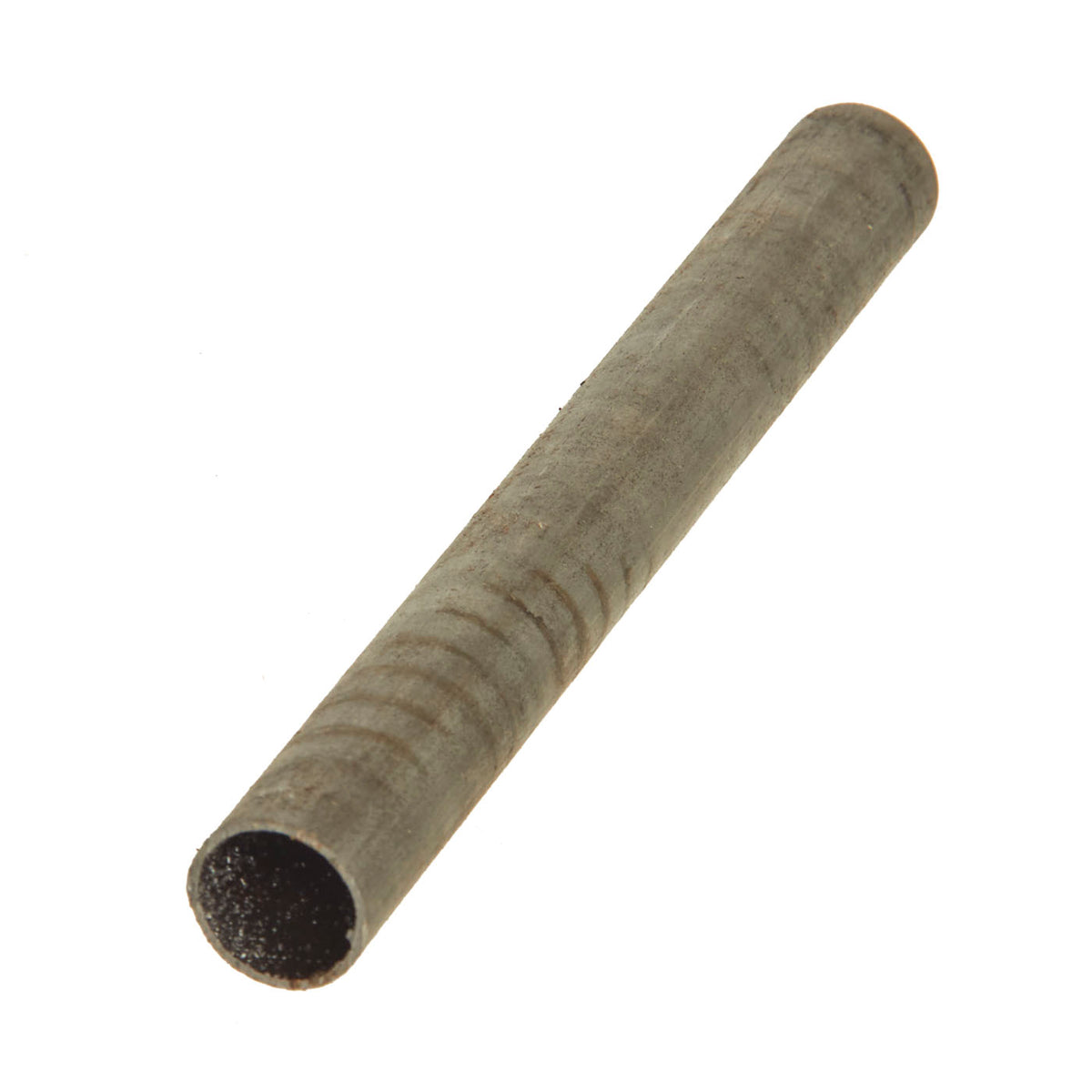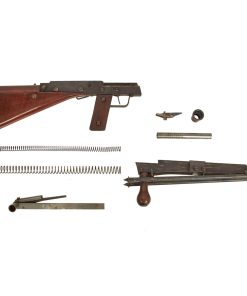Original French WWI Fusil-Mitrailleur Modèle 1915 CSRG Chauchat Saw Cut Lower Frame with Bipod, Cocking Handle & More Original Items
$ 1.295,00 $ 323,75
Original Item: Only One Set Available. Just purchased at a large military show, this is a fantastic collector’s opportunity! These are some “spare” parts from a French WWI Chauchat LMG, most likely all that is left after various components were used to repair other guns in service. However, even as that, this set has as the main item a saw cut complete lower frame / trigger group, which definitely used to be one piece prior to cutting just behind the “foregrip.”
The front portion measures just over 15 inches in length, and is still marked with the serial number next to the CSRG star:
SIDARME
C.S.R.G. No. 23617
The sling swivel, bipod, and foregrip are intact and functional. Even better, the magazine housing assembly and catch are intact and fully functional, tested with an original magazine! The front sling swivel is present as well. Above the foregrip on the same side there is SA in a rectangle, the mark of the Finnish Army (Suomen Armeija). Finland did acquire these in some number, and are a known user of the Chauchat. During the Winter War between Soviet Union and Finland, over 5,000 surplus Chauchats were donated by France to Finland, which was short on automatic weapons. The weapons arrived too late to see action but were used in Continuation War, mostly on the home front. After the war they were warehoused until 1955 and sold off.
The rear portion of the lower frame / trigger group measures a bit over 17 inches, and still has a functional trigger assembly, and the selector switch moves as well. It has an intact sling swivel, and the main issue is that the left grip scale has broken off, or was possibly removed.
Additional items included with the lower frame are what looks to be a complete cocking handle assembly, a spare sear, the two recoil springs, and part of what we believe is the buffer. There is also a cut off piece of tube that looks like it was part of the recoil spring assembly.
A fantastic set of Chauchat parts which would be a great foundation for use in building a BATF compliant non-gun. Having been in use during two world wars, one can only imagine what these parts have seen during their long life, and they also would make a great collectors set all on their own. Ready to display!
The Chauchat, named after its main contributor Colonel Louis Chauchat, was the standard machine rifle or light machine gun of the French Army during World War I (1914-18). Its official designation was “Fusil Mitrailleur Modele 1915 CSRG” (in English: “Machine Rifle Model 1915 CSRG”). It was mass manufactured during World War I by two reconverted civilian plants: “Gladiator” and “Sidarme”. Beginning in June 1916, it was placed into regular service with French infantry where the troops called it the FM Chauchat. The Chauchat machine rifle in 8mm Lebel was also extensively used in 1917-1918 by the American Expeditionary Forces (A.E.F) where it was officially designated as the “Automatic Rifle, Model 1915 (Chauchat)”. The armies of eight other nations, notably: Belgium, Finland, Greece, Italy, Poland, Romania, Russia and Serbia, also used the Chauchat machine rifle in fairly large numbers during and after World War I.
A total of 262,000 Chauchat machine rifles were manufactured between December 1915 and November 1918, including 244,000 chambered for the 8mm Lebel service cartridge, making it the most widely-manufactured automatic weapon of World War I. Besides the 8mm Lebel version, the Chauchat machine rifle was also manufactured in U.S. .30-06 Springfield and in 7.65×53mm Argentine Mauser caliber to arm the American Expeditionary Forces (A.E.F.) and the Belgian Army respectively. The Belgian military did not experience difficulties with their Chauchats in 7.65mm Mauser and kept them in service into the early 1930s,. Conversely the Chauchat version in U.S. .30-06 made by “Gladiator” for the A.E.F., the Model 1918, proved to be fundamentally defective and had to be withdrawn from service.
The Chauchat machine rifle was one of the first light, automatic rifle caliber weapons designed to be carried and fired by a single operator and an assistant, without a heavy tripod or a team of gunners. It set a precedent for several subsequent 20th century firearm projects, being a portable yet full power automatic weapon built inexpensively and in very large numbers. The Chauchat combined a pistol grip, an in-line stock, a detachable magazine, and a selective fire capability in a compact package of manageable weight (20 pounds) for a single soldier. Furthermore, it could be routinely fired from the hip and while walking (marching fire).
The muddy trenches of northern France exposed a number of weaknesses in the Chauchat’s design. Construction had been simplified to facilitate mass production, resulting in low quality of many metal parts. The magazines in particular were the cause of about 75% of the stoppages or cessations of fire. They were made of thin metal and open on one side, allowing for ingress of mud and dust. The weapon also ceased to function when overheated, the barrel sleeve remaining in the retracted position until the gun had cooled off. The stock setup also left much to be desired, with the butt stock wood being prone to cracking at the front due to the design. Even the weight of the gun itself would slowly cause the thin front end to tear away. Consequently in September 1918, barely two months before the Armistice of November 11, the A.E.F. in France had already initiated the process of replacing the Chauchat with the M1918 Browning Automatic Rifle. Shortly after World War I, the French army hastened to replace the Chauchat with the new gas-operated Mle 1924 light machine gun.
The Chauchat is the only full automatic weapon actuated by long recoil, a Browning designed system already applied in 1906 to the Remington Model 8 semi-automatic rifle: extraction and ejection of the empties takes place when the barrel returns forward, while the bolt is retained in the rear position. Over time, the Chauchat machine rifle’s just passable performance in its dominant version (the Mle 1915 in 8mm Lebel) and the failure of its limited version in U.S. 30-06 (the Mle 1918), have led some modern experts to assess it as the “worst machine gun” ever fielded in the history of warfare.
Caliber: 8x50R (also .30-06, 6.5×54, 7.92×57, 7.65×53)
Weight: 9.5 kg
Length: 1170 mm
Barrel length: 450 mm
Feed: curved box magazine, 20 rounds (16 rounds for .30-06)
Rate of fire: 240 rounds per minute
Fast Shipping with Professional Packaging
Thanks to our longstanding association with UPS FedEx DHL, and other major international carriers, we are able to provide a range of shipping options. Our warehouse staff is expertly trained and will wrap your products according to our exact and precise specifications. Prior to shipping, your goods will be thoroughly examined and securely secured. We ship to thousands clients each day across multiple countries. This shows how we're dedicated to be the largest retailer on the internet. Warehouses and distribution centres can be located throughout Europe as well as the USA.
Note: Orders with more than one item will be assigned a processing date depending on the item.
Before shipping before shipping, we'll conduct a thorough inspection of the items you have ordered. Today, the majority of orders will be delivered within 48 hours. The delivery time will be between 3-7 days.
Returns
The stock is dynamic and we cannot completely manage it because multiple stakeholders are involved, including our factory and warehouse. So the actual stock may alter at any time. It's possible that you may not receive your order once the order has been made.
Our policy is valid for a period of 30 days. If you don't receive the product within 30 days, we are not able to issue a refund or an exchange.
You can only return an item if it is unused and in the same state as the day you received it. You must have the item in its original packaging.
Related products
Uncategorized
Uncategorized
Uncategorized
Australian WWII Owen MK1 Machine Carbine SMG Custom Fabricated Replica with Sling Original Items
Uncategorized
Uncategorized
Uncategorized
Uncategorized
Uncategorized
Armoured Fighting Vehicles of the World: AFVs of World War One (Hardcover Book) New Made Items
Uncategorized
Uncategorized
Uncategorized
Uncategorized
Band of Brothers ORIGINAL GERMAN WWII Le. F.H. 18 10.5cm ARTILLERY PIECE Original Items
Uncategorized
Uncategorized
Uncategorized
Uncategorized
